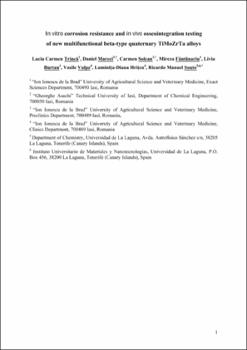In vitro corrosion resistance and in vivo osseointegration testing of new multifunctional beta-type quaternary TiMoZrTa alloys
Fecha
2020Resumen
The present study explores the in vitro and in vivo responses of new multifunctional
quaternary beta-type TiMoZrTa alloys designed for biomedical implantation. The
electrochemical resistance to corrosion of the alloys was investigated in vitro, using linear
potentiodynamic polarization (LPP) and electrochemical impedance spectroscopy (EIS) tests
in acidified physiological saline solution at 37 oC. The pH was adjusted to 4.0 by adding lactic
acid in order to simulate the hypoxia stress condition that may occur in the healing process of
fractures. The biomaterial alloys spontaneously formed a passivation oxide film on their
surfaces, which remained stable for polarizations up to +1.0 VSCE, and became more resistant
with the increased amount of Ta in the alloy composition. The animal tests of the quaternary
Ti-20Mo-7Zr-xTa alloys showed adequate biocompatibility as a tibial implant. Among them,
the 15% Ta-alloy implant showed the best osseointegration according to the results of the
biochemical, histological and computed tomography characterizations, and can be considered
as a potential biomaterial with low elastic modulus (43.6 GPa).






